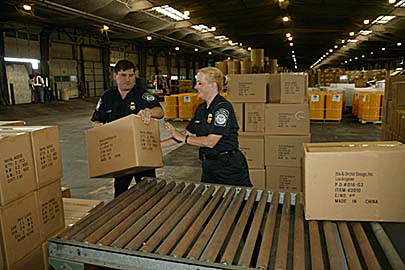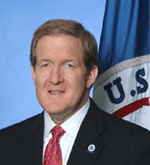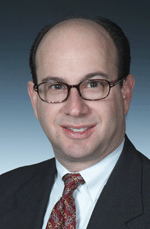TSA
Introduces New Rules
  "It's
a lot about background checks and security plans," said U.S. Transportation
Security Administration (TSA) Assistant Secretary Kip Hawley. "It's
a lot about background checks and security plans," said U.S. Transportation
Security Administration (TSA) Assistant Secretary Kip Hawley.
The Transportation Security Administration has
issued new air cargo rules that in one way or another will affect all
of the air cargo that flies above U.S. skies daily, in the first substantial
changes to air cargo regulations since 1999.
"Working with the industry we have set a
solid foundation,” Hawley continued.
"TSA is working with our partners on a series
of separate operational measures that raise security in air cargo."
The Air Cargo Final Rule makes permanent some
practices already in place and adds others.
The major dose of U.S. government intervention
in 2006 includes heightened criminal background checks for what could
be several hundred thousand airline and freight workers both on and off
U.S. airports.
TSA said it is adding more bomb-sniffing dogs
to screen cargo while also hiring 300 new air cargo inspectors this year.
Among other things, TSA focus is now cast upon
one portion of the air cargo business that delivers needed high yields
to combination carriers, those time sensitive airport-to-airport small
package express products.
The TSA plan also includes new regulations for
restricting access to sections of airports used for loading and unloading
cargo.
It also requires the employees of more than 4,000
freight forwarders to attend security-training courses designed by the
TSA.
Freight forwarders are being tasked to develop
security plans and have them approved by the government.
Hawley told reporters that Homeland Security Secretary
Michael Chertoff, (the same executive in charge of the ongoing management
mess associated with the New Orleans Hurricane Katrina disaster) came
up with the idea to require that small express packages delivered to the
airline ticket counters be further screened.
"If someone wants a package on a particular
flight, we want to be very sure about that," Hawley said.
Huh?
Last time we checked, small packages were getting
the same screening passengers and baggage receive.
Anyway, TSA also promises other big ideas including
surprise visits by air cargo inspectors, and daily checks against terrorist
watch lists of airport workers with access to sensitive sections of the
airport.
TSA also said it will consolidate 4,000 Known
Shipper lists into one so it can keep closer track of companies that ship
cargo on passenger planes.
All of this action has brought its share of industry
response.
 Brandon
Fried, Executive Director of U.S.-based Air Forwarders Association told
FT: Brandon
Fried, Executive Director of U.S.-based Air Forwarders Association told
FT:
“The Airforwarders Association has worked
closely with the TSA on developing enhanced layers of security for the
air cargo supply chain, including participating in the working group that
delivered over forty recommendations which informed many of the provisions
in the final rule issued yesterday.
“We support TSA's continued efforts to improve
supply chain security while ensuring that the flow of commerce that is
so vital to this nation's economy is not interrupted.
“The rules include provisions that require
background checks, more consolidation of information under TSA oversight
and other practical reforms to strengthen cargo security.
“Many of the rules build on existing security
measures practiced by air forwarders, such as security training, Known
Shipper reporting and extensive perimeter security protocols.
“In such an economically important and time-sensitive
industry as air cargo, it is vital that a layered approach is used to
ensure safety and security.
“We will continue to support TSA's risk-based
strategy to air cargo and will work closely to distribute information
to freight forwarders throughout the implementation process.”
For the record, TSA said that in recent weeks
it banned three companies from sending cargo on passenger aircraft.
|
TSA Not Super Says Clark Kent Ervin
.gif) On
March 28, 2006, undercover investigators penetrated both northern and
southern U.S. borders, and smuggled in enough radioactive material to
produce two dirty bombs. On
March 28, 2006, undercover investigators penetrated both northern and
southern U.S. borders, and smuggled in enough radioactive material to
produce two dirty bombs.
Although monitors at border checkpoints
were capable of detecting the radiological material, the agents were able
to provide papers that they had counterfeited using a basic computer program,
which allowed them to gain access to U.S. soil. Based on this shocking
investigation, it is clear that, four-and-a-half years after 9/11, “there
are still substantial blind spots in our nation’s homeland security
efforts,” criticized Clark Kent Ervin, a former Inspector General
of the U.S. State Department, at a recent security conference in Frankfurt,
Germany.
“Today we can presume that Homeland
Security, which claims to protect America against any kind of terrorist
activities, has not lived up to the promises it made four years ago,”
Ervin, a long time Bush friend and aide, who was hand picked in 2002 to
direct the newly formed DHS said.
Air cargo shipments on board of passenger
aircraft within the U.S. are highly vulnerable to any misuse, he says.
“Only a very small percentage of the
goods are being inspected prior to getting on board an aircraft.”
Although random controls are mandatory practically
none of these checks take place, he says.
“If you consider that 22 percent of
all domestic air cargo is being flown in the belly-hold compartments of
passenger jets there is an enormous risk potential,” warns Ervin.
To emphasize that the Netherlands, Great
Britain and Israel inspect 100 percent of all air freight prior to departure.
According to a bill that has been passed
through the U.S. Congress, this same action will not happen before 2008
in the USA.
“We only can hope that terrorists
will wait until then before starting any action.”
According to Ervin there are three major
reasons why the Department of Homeland Security and its offspring, the
Transport Security Administration (TSA), which is responsible for the
protection of about 450 U.S. airports, have widely failed to make air
transport more secure.
First argument is the lack of money:
“Homeland Security bundled 22 different
agencies with 180,000 employees and was provided with the individual budgets
of these offices, which amount to 40 billion dollars.
“But looking at the huge task DHS
has to fulfil it would need a tripling or quadrupling of this sum.”
What is needed is a combination of money, more and better technology such
as x-ray machines and efficient training of the security people, recommends
Ervin.
According to Erwin, another cause for the
DHS poor security performance is the lack of long-term security planning
by most U.S. citizens.
“We have a focus-on-the-moment-mentality.
“Four years is an eternity for Americans.
“So we are beginning to feel safe
again, because we haven’t been attacked since 9/11.
“Neither the broad public nor the
media put sufficient pressure on the TSA demanding pro-active and more
efficient steps to better the nation’s security situation.
“We sent undercover teams on various
occasions to test the security at our airports.
“The depressing outcome was that all
results were exact the same as prior to 9/11.
During his two-year term as Inspector General,
Ervin had sent numerous reports to Congress and DHS Secretary Tom Ridge,
citing security breakdowns and offering solutions to correct the problems.
In spite of this effort, Ervin contends
DHS swept the issues under the rug and branded him a renegade because
he refused to sugarcoat his findings.
At the Frankfurt meeting Ervin pointed out
that money and state-of-the-art technology at best can only prevent attacks.
“What these efforts cannot do is to
eliminate the roots of terrorism.
“This can only be achieved by a radical
change of U.S. foreign policy.
“The Iraq War as example doesn’t
abolish but supports the spreading of terror.”
Ervin’s complete thoughts on the DHS
can soon be read in a new book:
“Open Target—Where America is
Vulnerable to Attack” by Clark Kent Ervin, ISBN: 1-4039-7288-6,
256 pages, Palmgrave Macmillan. Publication Date : 06/30/2006
(Heiner Siegmund)
|



